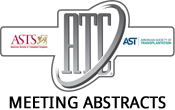2017 American Transplant Congress
In Vitro Optimisation of the Immunotherapeutic Effects of Umbilical Cord Derived MSC.
Mesenchymal stromal cells (MSC) possess immunomodulatory properties and are low immunogenic, which are both important for their development into an effective cellular immunotherapy after organ…2017 American Transplant Congress
Soluble Human Leukocyte Antigen-G Levels and Prolonged Allograft Survival: A Demographic Analysis.
Human leukocyte antigen-G (HLA-G) is a tolerogenic protein shown to contribute to allograft survival. Dimerized, soluble HLA-G (sHLA-Gd) has been shown to significantly prolong allograft…2017 American Transplant Congress
Circulating Inflammatory Factors in Deceased Organ Donors Result in Innate Immune Activation.
Surgery, Duke University, Durham, NC
Background: Superior outcomes of living-donor compared to deceased-donor transplants may be related to increased graft immunogenicity at the time of transplant. Donor brain death results…2016 American Transplant Congress
Immunogenic HLA-DR Eplet Mismatches as Predictors of Transplant Glomerulopathy.
BackgroundThe number of HLA-DR eplet mismatches (eplet load) is a risk factor for the development of anti-HLA antibodies and transplant glomerulopathy (TG). In the case…2016 American Transplant Congress
High Concentrations of CXCL9 and CXCL10 Chemokines but Not CXCL8 (IL-8), IL-6, TNF-a or IFN-g in Biopsy Tissue Are Associated with Pathological Staging of Rejection After Kidney Transplantation.
Background: Extensive expression profiling efforts of biopsy tissue after kidney transplantation indicate that rejection, especially antibody-mediated rejection (AMR) can be defined by distinct signatures. Thus,…2016 American Transplant Congress
A Novel Humanized Mouse Model Incorporating Non-Fetal Tissue.
Surgery/Transplant Division, University of Wisconsin-Madison, Madison, WI.
Pre-clinical research into allogeneic tissue transplantation therapies, as well as patient-specific regenerative medicine studies, require animal models that closely mimic the typical patient's immune response.…2016 American Transplant Congress
Activation of Innate Immunity During Human OLT-IRI Triggers Adaptive Immunity and Correlates with the Degree of IRI Injury.
1Surgery, Dumont-UCLA Transplant Ctr, Los Angeles, CA; 2Pathology, UCLA, Los Angeles, CA.
Ischemia reperfusion injury (IRI) in orthotopic liver transplantation (OLT) can severely compromise graft and recipient survival. We postulate this is mediated by interactions between the…2016 American Transplant Congress
Optimizing the Immunogenicity and Immunomodulatory Properties of MSC for Cellular Therapy.
Mesenchymal stromal cells (MSC) are candidates for immunotherapy after transplantation. MSC have shown to be immunomodulatory and low immunogenic, which is favorable for cellular therapy…2016 American Transplant Congress
Dendritic Cells and Damage-Associated Molecular Patterns in Aging.
Recently, it has been shown that Dendritic Cells (DCs) of old organs accelerate graft rejection by orchestrating IL-17A-mediated T cell responses. Moreover, cell-free DNA has…2016 American Transplant Congress
Biopsy-Proven Rejection in Children After Liver Transplantation Is Associated by an IL-12p40-Mediated Innate Immune Response Followed by Th1 T Cell Activation.
Sustained by adaptive immune cells and their soluble mediators is well established for infection but it has not been demonstrated for solid organ transplantation in…
- « Previous Page
- 1
- …
- 9
- 10
- 11
- 12
- 13
- Next Page »
